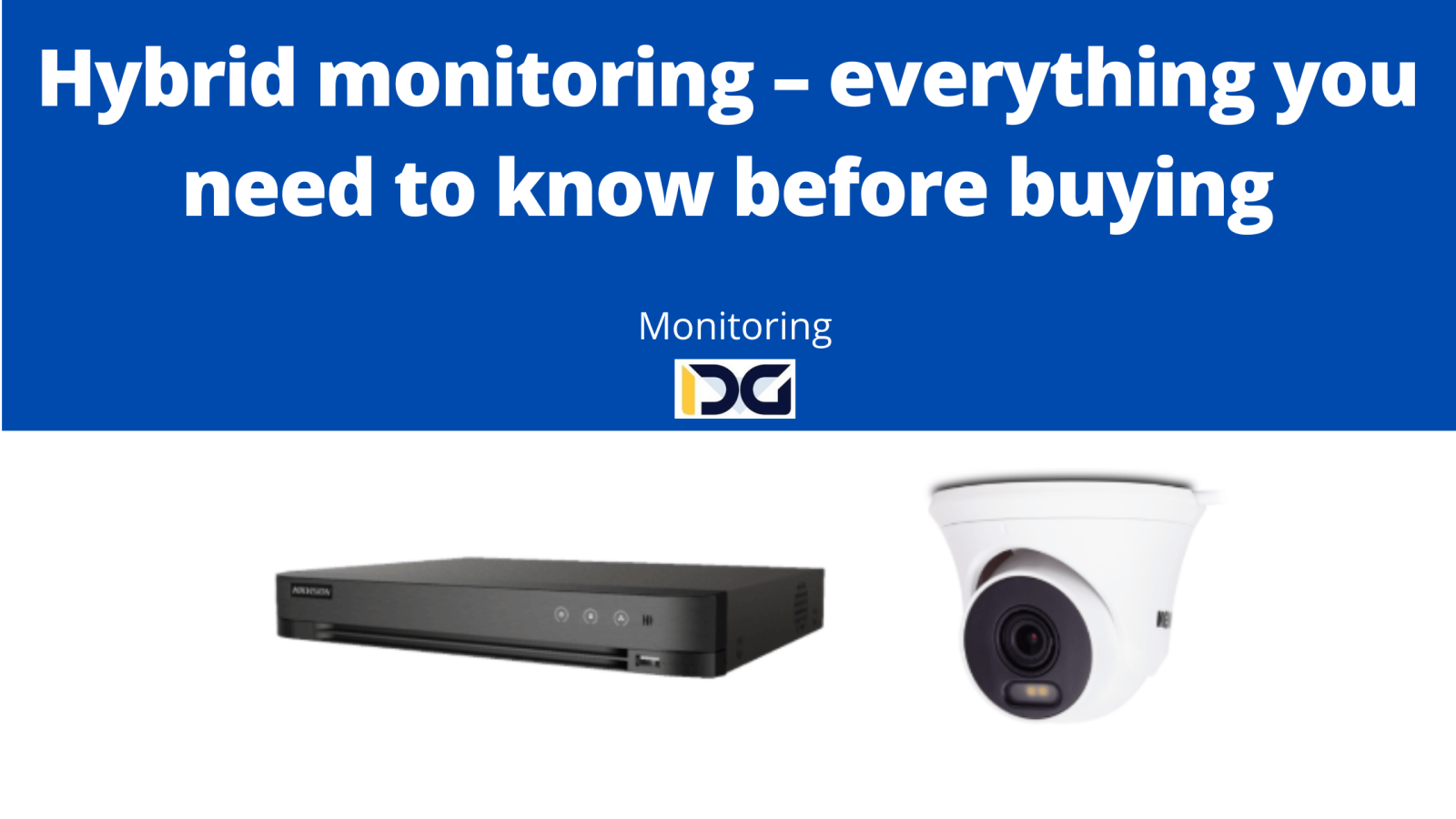
What is hybrid monitoring?
Hybrid monitoring is the combination of a traditional analog system with a modern IP system. This means that a hybrid recorder is capable of capturing and processing images from both analog and digital cameras. This allows for the integration of old and new equipment, resulting in cost savings during the system upgrade. It’s worth noting that the compatibility between analog and IP cameras may vary depending on the specific hybrid recorder and its capabilities, the hybrid recorder is capable of working with various types of cameras, such as CVBS, AHD, HDCVI, HDTVI, and IP, allowing for flexibility in equipment selection..
What is a hybrid camera?
The hybrid surveillance camera is a device that allows you to work in various image transmission systems, such as CVBS, AHD, HDCVI and HDTVI. Thanks to this, it is a very universal solution that allows you to adapt to different needs and requirements.
What is a hybrid recorder?
A hybrid recorder is a video and audio recording device that combines the functions of an analog and digital recorder. It is able to store data on a digital medium, such as a hard drive or memory card, and at the same time allows you to connect analog cameras and IP cameras to it. Thanks to this, it allows the use of already existing analog installations, and at the same time increases the possibilities by using CCTV solutions available only in IP monitoring.
Open this in UX Builder to add and edit content
What are examples of hybrid monitoring applications in various industries?
The continuous advancement of technology has led to hybrid monitoring being able to support features that were previously only available in IP monitoring, such as perimeter protection and artificial intelligence.
There are practically no limitations to the application of hybrid monitoring.
What are the key components of a hybrid monitoring system?
The main and essential components of hybrid monitoring include a hybrid recorder equipped with a hard disk drive (HDD), hybrid cameras also known as 4in1 cameras, camera power supply, and cabling.
In addition, the components of a hybrid monitoring system can include:
Video signal transmission components (e.g., video transformers), Data storage devices (e.g., external hard drives, cloud storage), Alarm devices (e.g., motion sensors, alarm sirens), Image analysis software (e.g., facial recognition, motion detection), Integration with other systems such as Automatic Person Identification (API) or external alarm systems.
What are the latest trends in the development of hybrid monitoring technology?
The main development is aimed at catching up with IP monitoring technology, primarily by increasing the maximum resolution of cameras and their compatibility.
The use of artificial intelligence and increased capabilities for adjusting hybrid camera settings are also significant trends.
Another important trend is the development of technology that enables the integration of hybrid monitoring with automatic image processing systems, such as image analysis, motion detection, and facial recognition. This allows hybrid monitoring systems to become increasingly intelligent and capable of automatically detecting and responding to potential threats.
The development of wireless data transmission technology from hybrid cameras to monitoring centers is another trend. This makes hybrid monitoring systems more flexible, easier to install, and maintain.
Furthermore, the advancement of cloud computing technology allows for the processing and storage of data from hybrid cameras in the cloud, enabling access from anywhere and facilitating the scalability of the monitoring system.
What are the infrastructure requirements needed to implement hybrid monitoring?
The implementation of hybrid monitoring requires appropriate infrastructure to ensure effective and reliable system operation. The basic infrastructure requirements include:
- Computer Network: A stable and high-speed computer network is required for transmitting data from cameras and other devices to the central server.
- Recorders: The recorders are responsible for storing, analyzing, and processing data from the monitoring system. They require high disk capacity and computational power.
- Cameras: Cameras can be both analog and digital, but it is important to ensure they are suitable for the specific conditions of the location.
- Software: Software for managing the hybrid monitoring system is crucial for its effective operation. It should enable management of cameras, recorders, and other devices, as well as provide tools for data analysis and processing.
- Power Supply: The hybrid monitoring system requires continuous and reliable power supply to ensure uninterrupted operation.
- Security Measures: The hybrid monitoring system should be protected against unauthorized access and cyber-attacks.
What are the costs related to the implementation and maintenance of hybrid monitoring?
Purchase and Installation of Equipment: Costs associated with the purchase and installation of cameras, recorders, servers, and other necessary devices for the system installation.
- Integrator Services Costs: If you decide to use the services of an integrator, you will incur costs related to system design, installation, and configuration.
- Data Transmission Fees: If the system utilizes an internet connection, there will be costs associated with data transmission.
- Software Fees: Costs related to the purchase or licensing of software for system management.
- Maintenance Costs: Costs associated with system maintenance, repairs, and updates, as well as fees for the system’s power consumption.
Estimated costs associated with the implementation and maintenance of hybrid monitoring can vary depending on the size and complexity of the system, as well as the choice of products and services. Therefore, it is important to accurately assess your needs and conduct a thorough cost analysis before making decisions regarding the purchase and installation of the system.
What are the prospects for the development of hybrid monitoring in the future?
The prospects for the future development of hybrid monitoring are very promising, as it allows for the combination of the advantages of traditional monitoring methods, such as CCTV, with modern technologies such as image analysis and artificial intelligence. This enables automatic threat detection and the delivery of more detailed information about situations. In the future, hybrid monitoring can also be used in a wider range of applications, such as city security, critical infrastructure, and transportation.
What are the main advantages and disadvantages of hybrid monitoring
Advantages of hybrid monitoring:
- Flexibility: Hybrid monitoring allows for the use of different types of cameras, such as IP, analog, or HD-TVI cameras, which provides flexibility to tailor the system to individual needs and requirements.
- High image quality: Hybrid monitoring enables the utilization of high-resolution cameras, enhancing the ability to capture clear and detailed images.
- Cost savings: Hybrid monitoring allows for the incorporation of existing analog cameras, resulting in cost savings by avoiding the need to install new devices.
- Ease of use: Hybrid monitoring facilitates the integration of various camera types and systems into a single platform, making it easier to operate and manage.
Disadvantages of hybrid monitoring:
- Cost: Hybrid recorders can be more expensive than other types of recorders because they require faster and more efficient processors to handle the additional task of compressing the camera images.
- Complexity: Hybrid monitoring can be more complex than other types of monitoring as it involves integrating different types of cameras and systems.
- Compatibility: Hybrid monitoring may require special software or hardware, which can hinder compatibility with other systems or devices.
- Susceptibility to electromagnetic interference: Hybrid monitoring may be more prone to electromagnetic interference, which can affect the quality and reliability of the system.
What are examples of hybrid monitoring applications in various industries?
Continuous technological advancements have led to hybrid monitoring being able to support features that were previously only available in IP monitoring, such as perimeter protection and artificial intelligence.
There are virtually no limitations to the application of hybrid monitoring.
- Building security: Hybrid monitoring allows for the integration of traditional alarm systems with IP cameras, enabling quick detection and response to alarming situations.
- Transportation: Hybrid monitoring is frequently used in transportation to ensure the safety of vehicles and cargo.
- Industrial applications: Hybrid monitoring is helpful in the industrial sector to increase efficiency and workplace safety. Hybrid cameras can monitor machine operations, detect potential failures, and prevent accidents.
- Education: Hybrid monitoring is employed in schools and educational institutions to enhance the safety of students and staff. Hybrid cameras can monitor classrooms and hallways and deter vandalism.
- Retail: Hybrid monitoring is utilized in retail stores to improve operational efficiency and security. Hybrid cameras can monitor customer traffic and prevent theft.
These are just a few examples of the diverse range of applications for hybrid monitoring.
What is AHD monitoring?
AHD (Analog High Definition) monitoring is a type of video surveillance system in which the video signal is transmitted in analog form but with high resolution. This means that the image is sharp and detailed, similar to digital image quality, while still remaining in analog form. This type of monitoring is often used in applications where high image quality is required, but due to long signal transmission distances, it is not feasible to use a digital system.
What is HD-CVI monitoring?
HD-CVI monitoring is a standard developed by Dahua Technology, which allows for the transmission of high-resolution (HD) images from cameras over conventional cables (such as coaxial) using the HD-CVI digital transmission standard. This enables the capture of high-quality images while also providing cost savings and ease of installation. HD-CVI monitoring is widely used in various types of facilities, including warehouses, manufacturing plants, retail stores, banks, and public institutions.
What is HD-TVI monitoring?
HD-TVI (High Definition Transport Video Interface) monitoring is a video surveillance system developed by Hikvision. It allows for the transmission of video signals from cameras over coaxial cables in HD format. This means that the image is transmitted in 1080p resolution or higher, resulting in a very high-quality picture. HD-TVI monitoring enables excellent image quality even in challenging lighting conditions and allows for long-distance signal transmission without the need for special converters. It is a commonly used solution in video surveillance installations in public buildings, warehouses, retail stores, and other similar environments.
